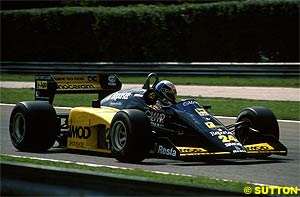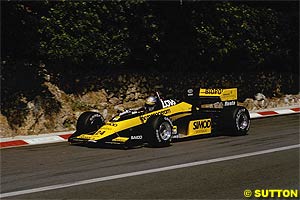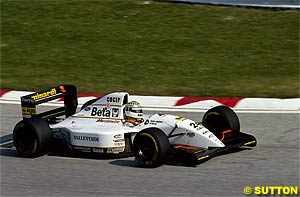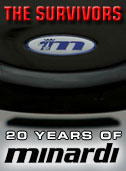
Atlas F1 Technical Writer
Despite the smallest of budgets of the Formula One field, the Minardi team have produced some remarkable cars over the years and have groomed some of the leading technical personnel in Formula One. Craig Scarborough looks back at the technical developments of the Anglo-Italian outfit during their two decades in the sport
Yet with this view of F1 there remains at least one true anachronism: Minardi. The team is closing 20 seasons in F1, over three hundred races and a scattering of points. Minardi may not fit in with the current brand of cutting edge technology, yet the tiny team from Faenza have also made their contribution to the sport's technological rush. Their contribution comes not only in the form of the technicalities of their cars but also the training ground: they have provided many engineers who are now the leading lights in the top teams.
Resources and Budget
I visited the factory in 2002, having been to most of the other F1 factories. The trouble I had finding their premises in a busy industrial estate in Faenza was the first evidence of the scale of the team's operation. The small anonymous unit had a modest reception with a scattering of team memorabilia - not the huge, mirror polished marble entries that grace larger teams, with show cars neatly sat on display.
I met the team's technical director Gabriele Tredozi; he spared me nearly an hour and afterwards I was shown around the factory, without the paranoid secrecy of other teams.
The machine and carbon shops were small; the drawing office housed a small team, not an army. Then, in the next door office, the aero team, numbering a handful, lead at the time by Loic Bigois. There was no wind tunnel, no extravagances. On Tredozi's wall was a year-planner, with a small number of days blocked out spread over the year. These were wind tunnel test dates.
Since the loss of Fondmetal, completing their aero development, the team had to fund their own design, model making and tunnel testing. How a Formula One car in the new millennium could be created from experience and by eye is astounding.
Technical
Yet with this ever present budget constraint, the team produced a new car model every year (aside from a B version of the M195 used in 1996). Finding engine deals has always been a problem; the team went through 13 changes of engines, albeit with several returns to Cosworth customer engines. They have also run almost every make of tyre supplier during their 20 years - from Goodyear to Pirelli, Michelin and Bridgestone. Yet with this constant change, the key role of the technical director has been limited to just four people.
Minardi's first F1 cars were large, ungainly looking machines, even in comparison to their rivals of the time. Yet they had a certain style, and even though the colour scheme came from a multitude of sponsors rather than single large corporate partner, they appeared cohesive and smart in black and yellow.
Fresh from his first job after University, Aldo Costa – now Rory Byrne's right hand man and heir apparent in Ferrari - joined Minardi as a designer, his motorsport experience coming from a placement at Ferrari resulting in a thesis on suspension.
Costa then took on the role of Minardi's technical director for 1988, replacing Calliri. Costa led the team and created fresh modern designs. His fashion for low slim cars allowed Minardi to emulate Tyrrell's knack for creating effective little cars. Even when the team sourced a rare supply of Ferrari engines and then Lamborghini units, the cars remained petite. During this time, the car's aerodynamics were designed initially by Nigel Cowperthwaite, Tommaso Carletti and then Rene Hilhorst. This was a rich period for the team with even a seventh position in the Constructors' Championship, until ownership issues of the team started to affect the design team.
In 1993, the experienced Gustav Brunner was hired as chief designer under Costa's lead, with Hilhorst on the aerodynamics. For two years the design team stayed together, when at the end of 1994 both left - Brunner to Ferrari and Hilhorst for Sauber, later to rejoin each other at Toyota in 2001.
After this, Minardi merged with Scuderia Italia, and Fondmetal became a partner in the team. It was their wind tunnel and related facilities that shaped the cars, under the eye of Mariano Alperin. This was a time of major changes to the cars, with new aerodynamic rules affecting the cars, and Fondmetal's assistance was invaluable, leading to the extreme high nose and short sidepod design of the M195\M195B.
The following period (1997-1998) saw the cars lose their sleekness, although the shapes were still developed by Fondmetal. The post-Costa era saw no points for the team.
1999 saw the team change once more, with Gustav Brunner tempted back after leaving Ferrari, and he created a new car with a number of innovations around the gearbox and suspension. Tredozi remained, albeit now in a chief designer role, aided on the aerodynamics by Jean Claude Migeot. These cars started to look more effective, with Brunner making the most of the resources and producing efficient cars.
Brunner started some of the developments that would remain with the team to this day. He worked with a local Italian casting specialist, CRP Cevolini, who undertook the development and bore the costs for a new cast titanium gearbox. This was pioneering work. At the time, magnesium cast gearcases were the norm. Minardi reaped four benefits from the new casing: a weight saving of 20-25%, dimension saving of 20%, torsion stiffness doubled and less gear wear/power absorption. As well as the gearbox were cast titanium uprights, steering rack and other suspension components.
Brunner also developed a pioneering rear suspension layout, placing the Sachs dampers vertically inside the gear casing and using a scissor action antiroll bar. All these features remain on Minardi to this day and have been adopted in some aspect by the other teams up and down the pitlane.
Tredozi took on the design reins once more, the planned deal for Supertec engines and Benetton gearboxes fell through and the team was left without a fully designed car and no rear end. The ex-Cosworth engines were rebuilt and tuned by Minardi's new owner Paul Stoddart and badged European-V10a in honour of his aviation company. The rest of the car was rapidly designed around the new rear-end and the chassis planned for the Supertec unit.
With the short lead times and increased crash testing, the new car was built without reference to a wind tunnel, as Fondmetal were no longer doing the whole aerodynamic development process for the team. Instead of Fondmetal designing, model making and tunnel testing parts, it was down to Minardi to fund and resource the process internally as a customer in the Fondmetal tunnel.
With Asiatec withdrawing free engines for 2003, Cosworth stepped in for a supply of the outdated CR3 units, similar in architecture to the Asiatec. The PS03 was an evolution of the PS02, with sleeker sidepods, cooling arrangements and lowered engine cover. Again Cosworth supplied revised CR3L engines in 2004, to last the full weekend mileage. The purchase of some 2002 Arrows chassis running the same engine did not divert the team's design theme, so the PS04 yet again evolved from the of PS02-03.
This car also scored the points for the team, although its pace meant it was mostly starting from the back row of the grid. For 2005, the team have again Cosworth engines, but with the massive aerodynamic rule changes, their ability to create a car quick enough to match their opposition, is the sort of challenge that the team have made their name from.
Formula One has always been about the application of high technology and consumption of enormous budgets in the process. Teams have grown and invested in ever larger facilities, carbon fibre departments, wind tunnels, bigger wind tunnels, seven post rigs and simulation departments. All this money and technology allows the top teams to gain fractions of a second over a lap. The law of diminishing returns means the more cash you have the smaller gains you'll find.
 Appearing in F1 in 1985, the team is now the fourth longest continuously serving team currently in F1. Only the top three teams of Ferrari, McLaren and Williams eclipse their tenure in the sport. Many other teams have come and gone during this period - many of these with much larger budgets. Minardi have always been on a shoe string and have still produced cars within the margin allowed to qualify for an F1 race.
Appearing in F1 in 1985, the team is now the fourth longest continuously serving team currently in F1. Only the top three teams of Ferrari, McLaren and Williams eclipse their tenure in the sport. Many other teams have come and gone during this period - many of these with much larger budgets. Minardi have always been on a shoe string and have still produced cars within the margin allowed to qualify for an F1 race.
 At Minardi, everything is sized to scale that the team can afford; they spend money only where they know it will reap performance rewards. At a time where everyone around F1 is saying cost cuts must be made and F1 has become too expensive, Minardi are a clear example that it doesn't need to be so expensive. How F1 could ever regulate to make teams as lean and cost efficient as Minardi is unanswerable. But certainly F1 would be a much better place if it were.
At Minardi, everything is sized to scale that the team can afford; they spend money only where they know it will reap performance rewards. At a time where everyone around F1 is saying cost cuts must be made and F1 has become too expensive, Minardi are a clear example that it doesn't need to be so expensive. How F1 could ever regulate to make teams as lean and cost efficient as Minardi is unanswerable. But certainly F1 would be a much better place if it were.
 The early cars, headed by Giacomo Calliri, were simple affairs, with elegant lines to hide the bulky packaging of the Motori Moderni (V6) turbo engines. Calliri was brought as designer from Minardi's F2 project, although he had previously designed cars for F1 with ATS. His last car, in 1988, featured a switch to normally aspirated engines, with the car becoming lower and sharper, bringing the team its first point with it.
The early cars, headed by Giacomo Calliri, were simple affairs, with elegant lines to hide the bulky packaging of the Motori Moderni (V6) turbo engines. Calliri was brought as designer from Minardi's F2 project, although he had previously designed cars for F1 with ATS. His last car, in 1988, featured a switch to normally aspirated engines, with the car becoming lower and sharper, bringing the team its first point with it.
 At the end of the year, Costa also left the team for Ferrari, were he remains to this day. His grounding at Minardi now sees him as the successor to Rory Byrne and possibly the largest design budget in F1. His Minardi co-designer Gabriele Tredozi then took the lead of the department, assisted by Mauro Gennari who together reworked the M195 into the B Model, complete with cockpit safety padding.
At the end of the year, Costa also left the team for Ferrari, were he remains to this day. His grounding at Minardi now sees him as the successor to Rory Byrne and possibly the largest design budget in F1. His Minardi co-designer Gabriele Tredozi then took the lead of the department, assisted by Mauro Gennari who together reworked the M195 into the B Model, complete with cockpit safety padding.
 Brunner's development was hindered by less than two days per month in the wind tunnel, so for the PS01 (2001) he had to focus on mechanical gains and simple aerodynamics. The new car was lower than all its competitors and used pullrod suspension to lower the centre of gravity. Yet as with all the team's previous designers he was again tempted away, this time to Toyota, to replace Andre de Cortanze. Brunner's ability to design a car that could be on the pace within short timescales was proven at Minardi and in demand by the fledgling Toyota F1 team.
Brunner's development was hindered by less than two days per month in the wind tunnel, so for the PS01 (2001) he had to focus on mechanical gains and simple aerodynamics. The new car was lower than all its competitors and used pullrod suspension to lower the centre of gravity. Yet as with all the team's previous designers he was again tempted away, this time to Toyota, to replace Andre de Cortanze. Brunner's ability to design a car that could be on the pace within short timescales was proven at Minardi and in demand by the fledgling Toyota F1 team.
 For 2002 the PS02 was formed around the adoption of a free supply of Asiatec engines. With Loic Bigois' input and some more wind tunnel time, the Minardi featured proper raised nose aerodynamics and pushrod suspension. When the car scored points first time out, in Melbourne, there was jubilation at the team, but the car was still firmly behind all of its rivals.
For 2002 the PS02 was formed around the adoption of a free supply of Asiatec engines. With Loic Bigois' input and some more wind tunnel time, the Minardi featured proper raised nose aerodynamics and pushrod suspension. When the car scored points first time out, in Melbourne, there was jubilation at the team, but the car was still firmly behind all of its rivals.
|
Contact the Author Contact the Editor |
Please Contact Us for permission to republish this or any other material from Atlas F1.
|
Volume 10, Issue 50
The Survivors: 20 Years of Minardi
Interview with Gian Carlo Minardi
The Passion of Stoddart
Making Something out of Nothing
The Minardi Factory Tour
Minardi's Cars Through the Lens
Minardi's Drivers Trading Cards
The Minardi Trivia Quiz
Regular Columns
On the Road
Elsewhere in Racing
The Weekly Grapevine
> Homepage |
